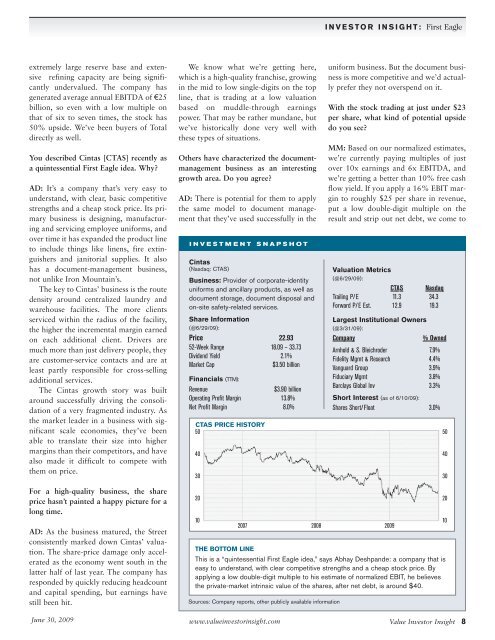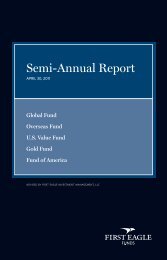Inside this Issue - First Eagle Funds
Inside this Issue - First Eagle Funds
Inside this Issue - First Eagle Funds
Create successful ePaper yourself
Turn your PDF publications into a flip-book with our unique Google optimized e-Paper software.
extremely large reserve base and extensive<br />
refining capacity are being significantly<br />
undervalued. The company has<br />
generated average annual EBITDA of €25<br />
billion, so even with a low multiple on<br />
that of six to seven times, the stock has<br />
50% upside. We’ve been buyers of Total<br />
directly as well.<br />
You described Cintas [CTAS] recently as<br />
a quintessential <strong>First</strong> <strong>Eagle</strong> idea. Why?<br />
AD: It’s a company that’s very easy to<br />
understand, with clear, basic competitive<br />
strengths and a cheap stock price. Its primary<br />
business is designing, manufacturing<br />
and servicing employee uniforms, and<br />
over time it has expanded the product line<br />
to include things like linens, fire extinguishers<br />
and janitorial supplies. It also<br />
has a document-management business,<br />
not unlike Iron Mountain’s.<br />
The key to Cintas’ business is the route<br />
density around centralized laundry and<br />
warehouse facilities. The more clients<br />
serviced within the radius of the facility,<br />
the higher the incremental margin earned<br />
on each additional client. Drivers are<br />
much more than just delivery people, they<br />
are customer-service contacts and are at<br />
least partly responsible for cross-selling<br />
additional services.<br />
The Cintas growth story was built<br />
around successfully driving the consolidation<br />
of a very fragmented industry. As<br />
the market leader in a business with significant<br />
scale economies, they’ve been<br />
able to translate their size into higher<br />
margins than their competitors, and have<br />
also made it difficult to compete with<br />
them on price.<br />
For a high-quality business, the share<br />
price hasn’t painted a happy picture for a<br />
long time.<br />
AD: As the business matured, the Street<br />
consistently marked down Cintas’ valuation.<br />
The share-price damage only accelerated<br />
as the economy went south in the<br />
latter half of last year. The company has<br />
responded by quickly reducing headcount<br />
and capital spending, but earnings have<br />
still been hit.<br />
We know what we’re getting here,<br />
which is a high-quality franchise, growing<br />
in the mid to low single-digits on the top<br />
line, that is trading at a low valuation<br />
based on muddle-through earnings<br />
power. That may be rather mundane, but<br />
we’ve historically done very well with<br />
these types of situations.<br />
Others have characterized the documentmanagement<br />
business as an interesting<br />
growth area. Do you agree?<br />
AD: There is potential for them to apply<br />
the same model to document management<br />
that they’ve used successfully in the<br />
INVESTMENT SNAPSHOT<br />
Cintas<br />
(Nasdaq: CTAS)<br />
Business: Provider of corporate-identity<br />
uniforms and ancillary products, as well as<br />
document storage, document disposal and<br />
on-site safety-related services.<br />
Share Information<br />
(@6/29/09):<br />
Price 22.93<br />
52-Week Range 18.09 – 33.73<br />
Dividend Yield 2.1%<br />
Market Cap $3.50 billion<br />
Financials (TTM):<br />
Revenue $3.90 billion<br />
Operating Profit Margin 13.8%<br />
Net Profit Margin 8.0%<br />
CTAS PRICE HISTORY<br />
50<br />
June 30, 2009 www.valueinvestorinsight.com<br />
40<br />
30<br />
20<br />
10<br />
INVESTOR INSIGHT: <strong>First</strong> <strong>Eagle</strong><br />
2007 2008 2009<br />
uniform business. But the document business<br />
is more competitive and we’d actually<br />
prefer they not overspend on it.<br />
With the stock trading at just under $23<br />
per share, what kind of potential upside<br />
do you see?<br />
MM: Based on our normalized estimates,<br />
we’re currently paying multiples of just<br />
over 10x earnings and 6x EBITDA, and<br />
we’re getting a better than 10% free cash<br />
flow yield. If you apply a 16% EBIT margin<br />
to roughly $25 per share in revenue,<br />
put a low double-digit multiple on the<br />
result and strip out net debt, we come to<br />
THE BOTTOM LINE<br />
This is a “quintessential <strong>First</strong> <strong>Eagle</strong> idea,” says Abhay Deshpande: a company that is<br />
easy to understand, with clear competitive strengths and a cheap stock price. By<br />
applying a low double-digit multiple to his estimate of normalized EBIT, he believes<br />
the private-market intrinsic value of the shares, after net debt, is around $40.<br />
Sources: Company reports, other publicly available information<br />
Valuation Metrics<br />
(@6/29/09):<br />
CTAS Nasdaq<br />
Trailing P/E 11.3 34.3<br />
Forward P/E Est. 12.9 19.3<br />
Largest Institutional Owners<br />
(@3/31/09):<br />
Company % Owned<br />
Arnhold & S. Bleichroder 7.9%<br />
Fidelity Mgmt & Research 4.4%<br />
Vanguard Group 3.9%<br />
Fiduciary Mgmt 3.8%<br />
Barclays Global Inv<br />
Short Interest (as of 6/10/09):<br />
3.3%<br />
Shares Short/Float 3.0%<br />
50<br />
40<br />
30<br />
20<br />
10<br />
Value Investor Insight 8



